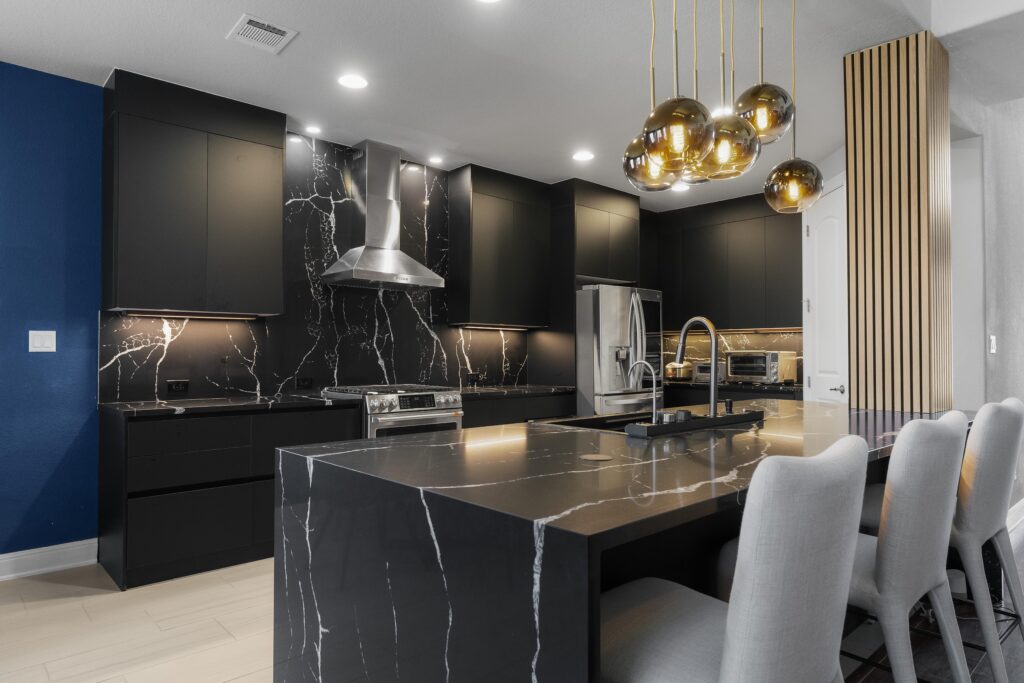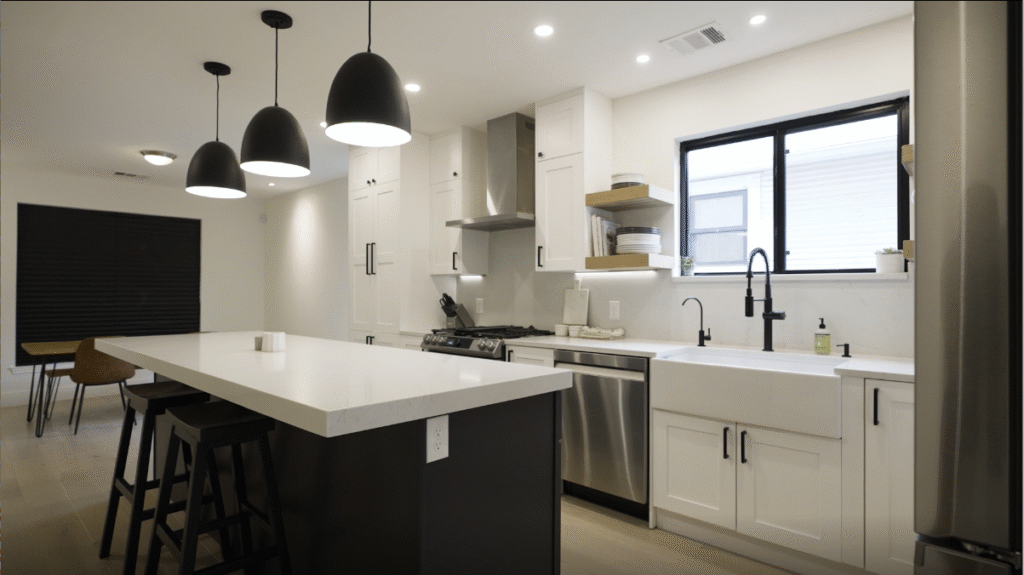Quartz vs. Granite Countertops: Which Is Right for Your Texas Home?
Choosing countertops is one of the most important decisions you’ll make during a kitchen or
bathroom remodel. The right surface needs to balance beauty, durability, maintenance requirements, and budget — all while complementing your home’s style and your daily lifestyle.
Two materials dominate today’s countertop market: quartz and granite. Both offer stunning aesthetics and long-lasting performance, but they have distinct characteristics that make each better suited for different situations. Understanding these differences is crucial to making the right investment for your home.
In this comprehensive guide, we’ll break down everything Austin and Dallas homeowners need to know about quartz and granite countertops, from composition and cost to maintenance and resale value. By the end, you’ll know exactly which material is right for your project.
Understanding the Basics: What Are These Materials?
Before diving into comparisons, it’s important to understand what you’re actually getting with each material.

Granite: Nature’s Original Stone
Granite is a 100% natural stone quarried directly from the earth. Formed over millions of years under intense heat and pressure, granite is an igneous rock composed primarily of quartz, feldspar, and mica. Each slab is completely unique, with one-of-a-kind patterns, veining, and color variations that can never be replicated.
After quarrying, granite slabs are cut, polished, and sealed before installation. The natural beauty and geological history embedded in each slab make granite a timeless choice that has been used in architecture for thousands of years.
Quartz: Engineered Perfection
Despite its name, quartz countertops are engineered surfaces, not pure natural stone. They’re manufactured from approximately 90-95% ground natural quartz crystals combined with 5-10% polymer resins, pigments, and binding agents.
This manufacturing process allows for consistent patterns, a wider range of colors, and enhanced durability compared to natural stone. While quartz contains natural materials, the engineering process gives manufacturers precise control over the final appearance and performance characteristics.

Head-to-Head Comparison: Quartz vs. Granite
Appearance and Design Options
Granite Wins for Natural Beauty
Granite offers unparalleled natural beauty with unique patterns that tell a geological story. No two granite slabs are identical, giving your kitchen a truly one-of-a-kind look. The depth and complexity of natural stone creates visual interest that catches light differently throughout the day.
Color options range from classic blacks, whites, and grays to dramatic blues, greens, golds, and reds. Popular styles include:
- Speckled patterns with consistent color distribution
- Bold veining resembling marble
- Dramatic movement with sweeping patterns
- Subtle, understated designs for minimalist spaces
Because each slab is unique, you must visit a stone yard to select your specific piece, ensuring you love the exact slab being installed in your home.
Quartz Wins for Consistency and Variety
Quartz provides predictable, uniform appearance without the natural variation of granite. This consistency makes it easier to visualize your finished space and ensures the sample you see matches what’s installed.
Modern manufacturing techniques allow quartz to mimic almost any look:
- Classic marble veining without the maintenance
- Concrete-inspired industrial designs
- Solid colors impossible to find in nature
- Sparkle and shimmer effects with reflective particles
- Wood grain patterns for creative applications
If you’re designing a modern, minimalist space or need multiple slabs that match perfectly (like for a large island), quartz offers advantages granite cannot.
Durability and Performance
Both Are Excellent, With Different Strengths
Granite Durability:
- Mohs hardness scale rating: 6-7 (very hard)
- Highly resistant to scratching from knives and cookware
- Excellent heat resistance — you can place hot pots directly on the surface
- Naturally resistant to UV fading, perfect for outdoor kitchens
- Can chip or crack if struck with heavy force on edges
- Porous nature requires sealing to prevent staining
Quartz Durability:
- Mohs hardness scale rating: 7 (harder than granite)
- Extremely scratch-resistant due to engineered composition
- Non-porous surface never needs sealing
- Highly resistant to staining from wine, coffee, oils
- Can be damaged by excessive heat (use trivets for hot pans)
- More flexible than granite, less prone to cracking during shipping
- UV exposure can cause discoloration over time (avoid outdoor use)
Maintenance Requirements
Quartz Wins for Low Maintenance
Quartz is virtually maintenance-free, making it ideal for busy households:
Daily Cleaning: Simply wipe with mild soap and water or gentle household cleaner. The non-porous surface doesn’t trap bacteria or require special products.
No Sealing Required: Unlike granite, quartz never needs sealing, saving time and money over the years.
Stain Resistance: The non-porous surface resists staining from most common household substances. Even red wine, coffee, and cooking oils wipe away easily.
Cautions: Avoid abrasive scrubbers, bleach, and harsh chemicals that can dull the surface. Always use cutting boards and trivets.
Granite Requires More Attention
Granite needs regular care to maintain its beauty and protection:
Sealing Schedule: Granite should be sealed upon installation and resealed every 1-3 years depending on the specific stone and usage. Some darker, denser granites need less frequent sealing.
Daily Cleaning: Use pH-neutral stone cleaners or mild dish soap. Avoid acidic cleaners like vinegar or lemon-based products that can etch the surface.
Stain Prevention: Because granite is porous, spills should be wiped promptly. Proper sealing creates a protective barrier, but prevention is key.
Testing Your Seal: Sprinkle water on the surface. If it beads up, your seal is good. If it absorbs within 10-15 minutes, it’s time to reseal.
Many homeowners find granite’s maintenance requirements manageable and appreciate the ritual of caring for natural stone.
Cost Comparison
Both materials span a wide price range depending on quality, color, and complexity.
Granite Countertops:
- Entry-Level: $40-$60 per square foot installed (common colors, standard edge)
- Mid-Range: $60-$100 per square foot installed (popular patterns, upgraded edges)
- Premium: $100-$200+ per square foot installed (exotic colors, rare patterns, complex fabrication)
Factors affecting granite cost include rarity of color, country of origin, slab thickness, and edge profile complexity.
Quartz Countertops:
- Entry-Level: $50-$70 per square foot installed (solid colors, simple patterns)
- Mid-Range: $70-$100 per square foot installed (popular brands, standard designs)
- Premium: $100-$200+ per square foot installed (designer collections, marble-lookalikes, complex edges)
Quartz tends to have a slightly higher entry price but more predictable costs since there are no surprises in the slab selection.
Average Kitchen Cost Comparison:
For a typical 50-square-foot kitchen with standard edges:
- Granite: $3,000-$7,500 installed
- Quartz: $3,500-$7,500 installed
Installation Considerations
Both Require Professional Installation
Neither granite nor quartz is suitable for DIY installation. Both materials are extremely heavy, require precise cutting and templating, and need specialized tools and expertise.
Granite Installation Process:
- Template creation of existing space
- Slab selection at stone yard
- Custom cutting and edge profiling
- Transportation to site (slabs are very heavy)
- Final fitting, leveling, and sealing
- Timeline: Typically 2-3 weeks from template to installation
Quartz Installation Process:
- Template creation of existing space
- Color/pattern selection (often from samples)
- Custom fabrication at facility
- Transportation to site
- Final fitting and securing
- Timeline: Typically 2-3 weeks from template to installation
Installation complexity and cost are similar for both materials. The main difference is that granite requires you to visit a slab yard, while quartz can often be selected from samples.
Health and Environmental Considerations
Quartz: Easier to Keep Sanitary
The non-porous nature of quartz makes it naturally more hygienic. Bacteria, mold, and mildew cannot penetrate the surface, making it easier to disinfect. This makes quartz popular in hospitals, restaurants, and homes with young children.
However, quartz manufacturing uses resins and chemicals, and some brands contain recycled materials that vary in environmental impact.
Granite: Natural But Porous
Granite is completely natural with no synthetic materials. It’s quarried and polished with minimal processing. However, its porous nature means bacteria can potentially harbor in microscopic pores if not properly sealed and maintained.
Properly sealed granite is perfectly safe and sanitary for food preparation. Many chefs prefer granite for its natural properties and heat resistance.
Environmental Impact:
Both materials have environmental considerations:
Granite:
- Quarrying impacts local ecosystems
- Heavy weight increases transportation emissions
- Natural resource that takes millions of years to form
- Can be reclaimed and reused
Quartz:
- Manufacturing process uses energy and chemical resins
- Some brands incorporate recycled materials
- Lighter weight reduces transportation impact
- Not easily recyclable due to resin content
Heat Resistance
Granite Wins for Heat Resistance
Granite is naturally heat-resistant due to its formation under extreme temperatures. You can safely place hot pots and pans directly on granite without concern, making it ideal for avid cooks who want convenience and durability.
Quartz Requires Caution
The polymer resins in quartz can be damaged by excessive heat. While quartz handles normal kitchen heat, placing very hot cookware directly on the surface can cause discoloration, cracking, or burning. Always use trivets or hot pads with quartz countertops.
For serious home cooks who frequently work with high-heat cooking methods, this limitation may influence the decision.
Resale Value and Home Appeal
Both Add Significant Value
Quality countertops are one of the top features homebuyers look for, and both granite and quartz are considered desirable, high-end options.
Granite’s Traditional Appeal:
- Long-established prestige and luxury association
- Timeless natural beauty appeals to traditional buyers
- Unique patterns create distinctive character
- “Real stone” perception adds authenticity
Quartz’s Modern Advantage:
- Increasingly popular with younger buyers
- Low-maintenance appeal to busy families
- Contemporary aesthetic fits modern design trends
- Consistent quality reduces buyer concerns
Real estate professionals generally consider both materials equivalent in terms of adding value. The choice depends more on your target buyer demographic and overall home style.
Best Use Cases for Each Material
Choose Granite If You:
- Love the unique, natural beauty of real stone
- Appreciate that no two slabs are identical
- Don’t mind periodic sealing maintenance
- Frequently place hot pots and pans on counters
- Want material suitable for outdoor kitchens
- Prefer traditional, timeless aesthetics
- Enjoy the ritual of caring for natural materials
- Have budget flexibility for rare, exotic colors
Ideal Granite Applications:
- Traditional kitchen designs
- Outdoor kitchen countertops
- Homes with rustic, farmhouse, or classic styling
- Baking stations where heat resistance matters
- Statement pieces with dramatic natural patterns
Choose Quartz If You:
- Prioritize low maintenance and easy care
- Want consistent color and pattern throughout
- Need stain resistance for busy households
- Prefer modern, contemporary aesthetics
- Want marble look without marble maintenance
- Have young children or pets
- Don’t want to worry about sealing schedules
- Value uniform appearance for large surfaces
Ideal Quartz Applications:
- Modern, minimalist kitchens
- Bathroom vanities in high-use spaces
- White or light-colored countertops (less maintenance than light granite)
- Commercial spaces requiring sanitary surfaces
- Homes with busy families needing durability
- Projects requiring perfect color matching across multiple slabs
Special Considerations for Austin and Dallas Homes
Texas Climate Factors
Heat and Sun Exposure:
Texas’s intense sun and heat affect countertop performance. Granite handles outdoor applications better, resisting UV damage and heat. Quartz can discolor with prolonged sun exposure, making it unsuitable for outdoor kitchens or areas with direct sunlight through large windows.
Humidity and Moisture:
Both materials handle Texas humidity well when properly installed. Granite’s sealed surface and quartz’s non-porous nature both resist moisture damage. Proper ventilation in bathrooms prevents any issues with either material.
Design Trends in Texas Markets
Austin: Leans toward contemporary designs with clean lines. White and gray quartz countertops are extremely popular, often paired with minimalist cabinetry and industrial elements. Natural materials like granite also fit Austin’s eco-conscious aesthetic.
Dallas: Embraces both traditional luxury and modern sophistication. Dramatic granite patterns remain popular in upscale homes, while transitional spaces often feature quartz for its versatility.
Resale Considerations by Market
Both Austin and Dallas are strong real estate markets where quality countertops add significant value. Austin buyers often prioritize low-maintenance features, while Dallas luxury buyers may gravitate toward unique granite selections. Either material is considered a smart investment in both markets.
Making Your Decision: Key Questions to Ask
Still undecided? Consider these questions:
1. What’s your cooking style?
- Heavy use of hot cookware → Granite
- Moderate cooking with concern for stains → Quartz
2. How much time can you dedicate to maintenance?
- Minimal time for upkeep → Quartz
- Don’t mind periodic sealing → Either works
3. What’s your design aesthetic?
- Love natural, unique patterns → Granite
- Prefer consistent, modern looks → Quartz
4. Do you have an outdoor kitchen?
- Yes → Granite only
- No → Either works
5. What’s your budget?
- Both span similar price ranges
- Factor in long-term sealing costs for granite
6. How long do you plan to stay in your home?
- Long-term (10+ years) → Choose what you love
- Short-term (5 years) → Consider broad market appeal
7. Do you have young children?
- Yes → Quartz’s stain resistance may be advantageous
- No → Either material works well
Alternative Materials Worth Considering
While quartz and granite dominate the market, other options exist:
Marble: Stunning natural stone with elegant veining, but requires significant maintenance and is prone to etching and staining. Best for low-use areas or design purists willing to embrace patina.
Quartzite: Natural stone that’s harder than granite with marble-like appearance. More expensive but extremely durable. Often confused with quartz (engineered) but is actually natural.
Porcelain Slabs: Emerging option with excellent durability, heat resistance, and low maintenance. Can mimic any material. Limited installer availability in some markets.
Solid Surface: Seamless appearance and repairable, but less heat-resistant and more prone to scratching than stone options.
Butcher Block: Warm, natural wood option for specific areas. Requires regular maintenance but creates inviting, functional work surfaces.
How to Get the Most Value From Your Investment
Regardless of which material you choose, maximize your investment with these tips:
Design Smart
Edge Profiles: Fancy edges look beautiful but increase cost. Standard eased or beveled edges provide clean looks at lower prices. Save decorative edges for focal points.
Slab Layout: Minimize seams by working with your fabricator on optimal slab layout. Fewer seams mean better appearance and lower cost.
Backsplash Coordination: Full-height stone backsplashes create dramatic impact but increase costs significantly. Consider complementary tile for budget savings.
Sink Selection: Undermount sinks showcase stone edges beautifully. Coordinate sink cutout placement to minimize waste.
Choose Reputable Fabricators
Quality fabrication makes the difference between good and great results:
- Verify they’re licensed and insured
- Review portfolio of completed projects
- Check references and online reviews
- Ensure they provide written warranties
- Confirm they use modern equipment for precise cuts
- Ask about their templating process
Protect Your Investment
For Granite:
- Seal upon installation and maintain sealing schedule
- Use cutting boards and trivets consistently
- Clean spills promptly, especially oils and acids
- Use coasters under glasses to prevent ring marks
- Reseal annually in high-use areas
For Quartz:
- Use trivets for all hot items
- Avoid harsh chemicals and abrasive cleaners
- Use cutting boards to prevent unnecessary wear
- Clean regularly with mild soap and water
- Avoid prolonged sun exposure
Document Everything
Keep records of:
- Material specifications and color names
- Fabrication and installation dates
- Warranty information
- Sealing schedule (for granite)
- Fabricator contact information
- Care and maintenance instructions
This documentation helps with future repairs, remodeling, or when selling your home.
Together Design & Build: Your Countertop Experts
Choosing between quartz and granite is just the beginning. At Together Design & Build, we guide Austin and Dallas homeowners through every step of the countertop selection and installation process.
Our Complete Countertop Service
Expert Consultation: We help you evaluate your needs, lifestyle, and design goals to determine which material truly fits your situation — not just what looks good in photos.
Material Selection: Access to premium granite and quartz suppliers with hundreds of options. We coordinate slab yard visits for granite selection or provide comprehensive quartz samples for your review.
Professional Design: 3D renderings show exactly how your chosen countertops will look in your space before installation begins. Visualize edge profiles, backsplash options, and overall design.
Precision Fabrication: We work exclusively with top-rated fabricators who use laser templating and CNC cutting for perfect fits and seamless installations.
Complete Installation: Licensed professionals handle removal of old countertops, plumbing adjustments, installation, and final sealing, leaving your space clean and ready to use.
Warranty Protection: Comprehensive warranties cover both materials and workmanship, giving you peace of mind for years to come.
Why Choose Together Design & Build?
Local Expertise: Deep knowledge of Austin and Dallas markets, design trends, and material performance in Texas climate
Transparent Pricing: Detailed quotes with no hidden fees. You’ll know exactly what you’re paying for before any work begins.
Quality Partnerships: Relationships with premier stone suppliers ensure access to best selection and competitive pricing
Project Management: Single point of contact manages all trades, scheduling, and quality control
Customer Satisfaction: 4.9-star average rating from hundreds of completed projects
Timely Completion: 95% of projects completed on schedule without compromising quality
Ready to Transform Your Kitchen?
Whether you choose the natural elegance of granite or the engineered perfection of quartz,
Together Design & Build ensures flawless results that enhance your home’s beauty and value.
Serving homeowners throughout Austin and Dallas, TX
Call us today at (833) 400-6110 or schedule your free countertop consultation online.
Together Design & Build
Your 5-Star Partner for Complete Home Remodeling & Construction
Because everything you imagine — our team can build.
Free Countertop Consultation Includes:
- In-home design evaluation
- Material recommendations based on your needs
- Detailed cost estimates for quartz and granite options
- Review of edge profiles and design details
- Timeline and process overview
- Answers to all your questions
- No obligation — just expert guidance
Licensed • Insured • Locally Owned • 100% Satisfaction Guaranteed





